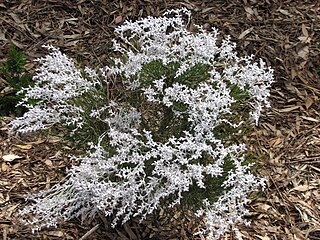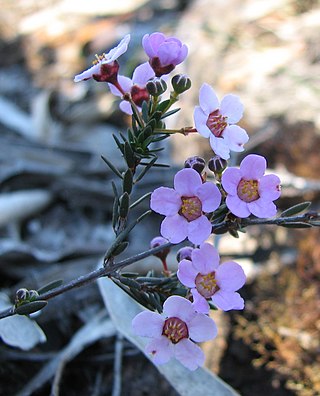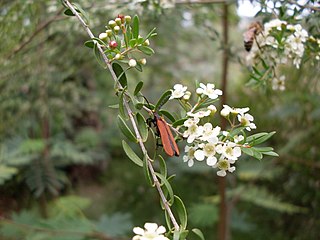
Austromyrtus is a genus of shrubs in the myrtle family Myrtaceae. Three species are found along the east coast of Australia; in Queensland and in New South Wales and A. lotoides being endemic to New Caledonia. The fruits of A. dulcis have a hint of cinnamon flavouring. The species under this generic name in New Caledonia are being taxonomically revised and will be transferred to another genus.

Conospermum stoechadis, commonly known as common smokebush, is a shrub endemic to Western Australia.

Euryomyrtus is a genus of shrubs, in the family Myrtaceae, all of which are endemic to Australia.

Carpobrotus virescens, commonly known as coastal pigface, is a prostrate coastal succulent shrub of the family Aizoaceae native to Western Australia. The Noongar peoples know the plant as Kolbogo or Metjarak.

Sesuvium portulacastrum is a sprawling perennial herb in the family Aizoaceae that grows in coastal and mangrove areas throughout much of the world. It grows in sandy clay, coastal limestone and sandstone, tidal flats and salt marshes, throughout much of the world. It is native to Africa, Asia, Australia, Hawai`i, North America and South America, and has naturalised in many places where it is not indigenous.
Atriplex bunburyana, commonly known as silver saltbush, is a species of saltbush endemic to Western Australia.

Euryomyrtus ramosissima, the rosy baeckea, is a shrub in the myrtle family (Myrtaceae). The species is endemic to Australia. It is spreading in habit and grows to 60 cm in height. Its leaves are dark green, long and narrow ranging from 3 to 13 mm in length and 1 to 3 mm in width. White, pink or mauve flowers with circular petals are produced between June and February in its native range.
Seorsus is a genus of flowering plants in the family Myrtaceae. The occurrence of the four species in Australia and Borneo is widely spaced, and is thought to be indicative that the genus predates the breakup of Gondwana.

Astartea fascicularis is a species of flowering plant in the myrtle family, Myrtaceae. It is endemic to southwestern Western Australia, where it is widespread in the Recherche Archipelago and present on the mainland in Cape Le Grand National Park. It is commonly known as Recherche astartea. or false baeckea.

Sannantha is a genus of flowering plants in the family Myrtaceae that are native to Australia and New Caledonia. Plants in the genus Sannantha are shrubs or trees with leaves arranged in opposite pairs, flowers usually arranged in small groups, the peduncles often 1.5–2 times as long as the pedicels and with seven to fourteen stamens. The fruit is a thin-walled capsule containing flattened, D-shaped seeds. Some species of Sannantha were previously included in the genus Babingtonia.

Adenanthos pungens, the spiky adenanthos, is a species of shrub in the family Proteaceae. It is endemic to the south-west of Western Australia.

Acacia exudans, also known as Casterton wattle, is a shrub species that is endemic to Australia. The species was formally described by English botanist John Lindley in 1838 from material collected on Thomas Mitchell's expedition near Casterton, Victoria in 1836. The description was published in Mitchell's Three Expeditions into the interior of Eastern Australia.
Kardomia is a genus of flowering plants in the family Myrtaceae. The genus was first formally described in 2007 and includes species previously included in Baeckea and Babingtonia. The entire genus is native to northeastern Australia
- Kardomia granitica(A.R.Bean) Peter G.Wilson
- Kardomia jucunda(S.T.Blake) Peter G.Wilson
- Kardomia odontocalyx(A.R.Bean) Peter G.Wilson
- Kardomia prominens(A.R.Bean) Peter G.Wilson
- Kardomia silvestris(A.R.Bean) Peter G.Wilson
- Kardomia squarrulosa(Domin) Peter G.Wilson
Babingtonia is a genus of flowering plants in the myrtle family, Myrtaceae. The species are native to Australia. Many species formerly placed in the genus are currently included in Sannantha, Baeckea, Oxymyrrhine, Kardomia, Seorsus and Harmogia.

Sannantha virgata is a flowering shrub species in the myrtle family, Myrtaceae. It is endemic to New Caledonia. Plants grow to between 0.5 and 3 metres high. White flowers appear in spring or summer with 5 rounded petals surrounding 7 to 10 stamens. The fruits are 1–2 mm wide and 2–3 mm in length.

Sannantha pluriflora, commonly known as tall baeckea, is a flowering shrub or small tree species in the myrtle family, Myrtaceae. It is endemic to Australia. Plants grow to 4 metres high. White flowers appear in groups of three to seven between October and April in the species' native range. These have five rounded petals surrounding 8–15 stamens. The fruits are 2.5 to 3.5 mm in diameter.
Sannantha similis is a flowering shrub or small tree species in the myrtle family, Myrtaceae. It is endemic to Australia. Plants grow to 4 metres high. White flowers appear in groups of 3 to 7 between October and January in the species' native range. These have 5 rounded petals surrounding 8 to 15 stamens. The fruits are 2.5 to 3.5 mm in diameter.

Cheyniana is a genus of flowering plants in the family Myrtaceae. Two species are currently recognised, both endemic to Western Australia:

Syzygium cormiflorum, commonly known as the bumpy satinash, is a species of Syzygium tree endemic to Queensland in northeastern Australia.
Westringia cremnophila, commonly known as Snowy River westringia, is a flowering plant in the family Lamiaceae, a rare shrub that is endemic to Victoria, Australia. It is a small shrub with leaves mostly in groups of three and white flowers.













